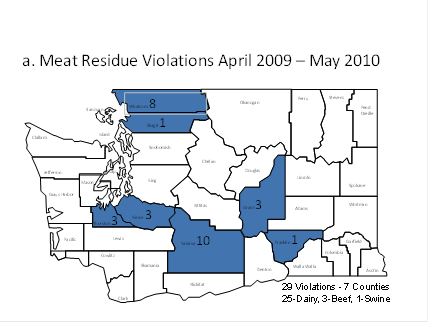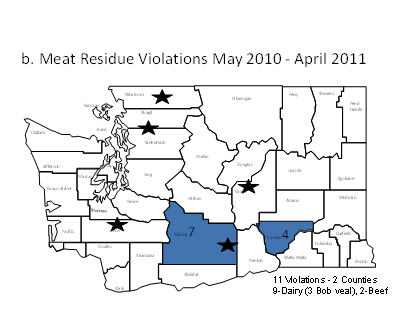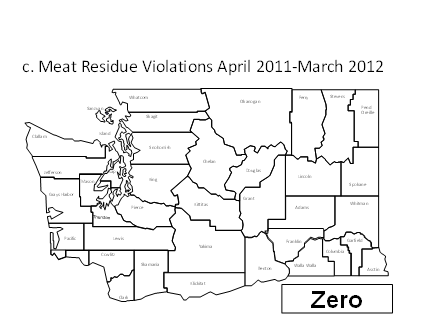 |
February 2015
|
February 2015 // Volume 53 // Number 1 // Ideas at Work // v53-1iw4
Responding Quickly to an Issue: A Collaborative Approach to Drug Residue Prevention
Abstract
Responding to current issues requires Extension educators to quickly react and collaborate. The Washington Department of Agriculture requested help developing and conducting outreach programs on dairy cattle drug residue prevention as a result of a new program announced by the US FDA. Curriculum focused on causes of residues and improving treatment records. Five face-to-face sessions with over 180 farmers and veterinarians and 360 views of an online program indicated interest. Over 65% of attendees intended to review their treatment protocols. A concomitant reduction in residue violations from dairy animals in the state was seen after the programs.
Introduction
In 2010, the US Food and Drug Administration (FDA) announced they would increase testing scrutiny of milk due to residues seen in cull dairy cow tissues (Lee, 2010). Every tanker load of milk is tested for beta-lactam antibiotics. Because many tissue violations were from residues from other drugs, the agency intended to test milk for drugs such as anti-inflammatories and other antibiotics. Dairy farms with repeat residue violations were the focus of FDA testing.
After initial announcement of FDA's new program, dairy organizations, processors, veterinarians, and magazines provided information on the program to producers. Although residue violators were the focus, the announcement sparked general interest in the industry. The Washington State Department of Agriculture (WSDA) contacted the dairy industry and Washington State University (WSU) Extension about collaborating on producer education on residue prevention. This article describes collaborations for curriculum development, program delivery, and educational opportunities discovered as a result of the program.
Collaborations and Curriculum Development
The WSDA pulled together Extension and dairy organizations and led presentations on the FDA testing program. Extension was contracted to coordinate activities and provide specific drug use and animal health content. Dairy organizations and a pharmaceutical company provided monetary and recruitment support.
The WSDA shared summary data from FDA focused on western cattle residue violations (Table 1). Most violations were from dairy cattle and bob veal (calves slaughtered within a few days of birth). In reviewing reasons for residues (Kaneene & Alwynelle, 1987; Gibbons-Burgener, 1999), education needed to focus on extra-label drug use and record-keeping. Word from the field was that many veterinarians and producers were already reviewing their treatment protocols but still had questions about testing processes and consequences and specific reasons for residues seen in dairy cattle.
| Drug Name | Bob Veal | Bulls/ Stags | Cows Beef | Cows Dairy | Heavy Calves | Heifers | Steers | Total |
| Ampicillin | 1 | 3 | 4 | |||||
| Desfuroylceftiofur* | 1 | 29 | 30 | |||||
| Flunixin | 1 | 1 | 65 | 1 | 68 | |||
| Gentamicin | 2 | 9 | 2 | 2 | 15 | |||
| Ivermectin | 2 | 2 | ||||||
| Neomycin | 36 | 6 | 2 | 1 | 45 | |||
| Oxytetracycline | 1 | 11 | 12 | |||||
| Penicillin | 102 | 102 | ||||||
| Sulfadimethoxine | 2 | 77 | 1 | 80 | ||||
| Sulfamethazine | 20 | 5 | 25 | |||||
| Sulfamethoxazole | 2 | 2 | ||||||
| Tetracycline | 11 | 11 | ||||||
| Tilmicosin | 4 | 1 | 1 | 6 | ||||
| Tylosin | 1 | 1 | ||||||
| Total | 46 | 2 | 2 | 337 | 4 | 1 | 11 | 404 |
| *A metabolite of the antibiotic ceftiofur. | ||||||||
To address these needs, the curriculum attempted to answer the following.
- What is FDA's concern and their plan for milk testing? What are current drug residue issues? WSDA.
- What are major reasons for residues from specific drugs found in market dairy cow tissues and how does that inform prevention? WSU.
- How can "Good Health Records" reduce the number of cows needing treatment, determine if treatments are working, and better track drug withdrawal times? WSU.
- What are current requirements for non-ambulatory cows and what role do they play in food safety? WSDA.
Program Delivery
Meeting advertising was conducted by all collaborators with a target audience of producers, herd managers, and veterinarians. Five meetings were held March through April, 2011. At each meeting, producers received the Milk and Dairy Beef Drug Residue Prevention Manual (National Milk Producers Federation, 2011) and information about an online market cow program for employees (Dalton, Moore, & Poe, 2007).
An audience response system (ARS) (Turning Point®, Turning Technologies, Youngstown, OH) was used to gauge current knowledge and practices and intention to change (Salmon, 2005). Data from the ARS was summarized in a computerized spreadsheet (Table 2).
| During the presentation | Correct Answers (Total responses) | % Correct Answers |
| Drug withdrawal times are based on: | 68 (104) | 65% |
| The reason we see so many bob veal calves with residues is because these calves: | 23 (109) | 21% |
| The major reason a cow might have a flunixin residue is because they were given the drug: | 92 (106) | 86% |
| The most likely reason cows might have a penicillin residue is because the drug was given: | 104 (108) | 96% |
| The most likely reason for a desfuroylceftiofur residue in a cow is: | 43 (100) | 43% |
| Which (sulfa) drug can I legally use in a lactating cow?* | 56 (95) | 59% |
| After the Presentation | Strongly Agree | Agree | Disagree | Strongly Disagree |
| As a result of this program, I am likely to talk with my veterinarian about farm drug use. | 60 (63%) | 31 (33%) | 2 (2%) | 2 (2%) |
| As a result of this program, I will talk with employees who handle drugs on my farm. | 75 (77%) | 21 (22%) | 1 (1%) | 0 |
| As a result of this program, I will take another look at my treatment records. | 77 (69%) | 31 (28%) | 3 (3%) | 0 |
For those unable to attend the meetings a narrated slide set covering reasons for residues was posted online <http://breeze.wsu.edu/p42969801/>. Website "hits" to the course page were evaluated.
Results
More than 180 producers, dairy employees or veterinarians attended. Over 130 audience members responded at least once using the ARS (Table 2). Most participants were aware that giving an extra-label dose of penicillin was a primary reason for residues, but few knew that a common reason for residues in bob veal was feeding milk replacers medicated with neomycin. With regards to "intent-to-change," over 63% strongly agreed that they were likely to talk to their veterinarian about farm drug use as a result of the program, and more than 75% strongly agreed that they would talk with employees who handle drugs on their farm. Over 65% strongly agreed that they would take another look at their treatment records.
Most ARS records questions sought information on current practices and treatment record quality (Table 3). Although most (68%) responded that their records could answer individual cow treatment or culling questions, only 39% thought they could provide all the information needed during a residue violation investigation. When provided rules of good record-keeping, 94% indicated they may or probably would implement them and a third would probably contact someone about implementing good health records.
| Question | Number | Percent |
| Which dairy management software is used on your dairy? | ||
| None | 20 | 20% |
| DC305 | 38 | 38% |
| DHI Plus | 20 | 20% |
| Dairy Plan | 12 | 12% |
| Other | 9 | 9% |
| Can your health records answer individual cow treatment or culling questions? | ||
| Yes | 65 | 68% |
| No | 20 | 21% |
| Don't Know | 10 | 11% |
| Can your health records answer cow ID, treatment date, drug used, dose given, route of administration, withdrawal time for meat and milk, individual who administered drug, if recommended by a veterinarian, date animal can be slaughtered or milk can be used? | ||
| Yes | 33 | 39% |
| No | 46 | 54% |
| Don't Know | 6 | 7% |
| Can your health records answer the question: Why was the drug given? | ||
| Yes | 45 | 54% |
| No | 37 | 44% |
| Don't Know | 2 | 2% |
| Can your health records determine % clinical mastitis requiring re-treatment last month? | ||
| Yes | 49 | 52% |
| No | 35 | 37% |
| Don't Know | 11 | 12% |
| Do you currently use Treatment Tracking Tools (DC305 Protocols or RxPlus)? | ||
| Yes | 20 | 45% |
| No | 24 | 55% |
| How likely are you to implement the Rules of Good Recording? | ||
| Probably Will | 78 | 77% |
| Maybe Will | 17 | 17% |
| No Chance | 6 | 6% |
| How likely are you to contact us about being a Demo Herd or for help achieving "Good Health Records? | ||
| Probably | 32 | 34% |
| Maybe | 44 | 46% |
| No | 19 | 20% |
An additional program with over 55 attendees was conducted in Idaho. An article was written about the website presentation by Bovine Veterinarian magazine (October 2011, Pg. 21), with a print readership of over 10,000. The online presentation had over 360 views July, 2011, to April, 2012.
The number of tissue residues reported from the state declined after the programs. There were 25 dairy cow tissue residue violations before the meetings, nine the year after, and zero the following year (Figure 1).
Figure 1.
Meat Drug Residue Violations Reported by the US Food and Drug Administration by County from April 2009 Through April 2012, in Washington State and Locations of Residue Prevention Producer Meetings


*Star represents location of residue prevention meetings held March-April, 2011.

Discussion
Collaborations among state government, industry, and Extension can quickly address an important issue and not only bring different resources but also promote consistent messages (Moore et al., 2004). Although the program did not reach everyone who might need the information, it did reach someone from about 25% of the state's dairy farms. The coincidental decline in residues in the state could be attributed to outreach programs or media attention and concomitant implementation of new drug use practices.
The ARS identified educational opportunities on good health and treatment records. Because few attendees understood sulfa-drug issues, a subsequent Extension article was written about reasons for sulfa-drug residues (Moore, 2011).
The inability of many farmers' treatment records to provide information needed in an investigation puts them at risk for punitive action, even if they follow all the rules. Poor documentation is a major reason for drug residues (Kaneene & Alwynelle, 1987). As a result of the program described here and investigations into health records (Wenz & Giebel, 2012), a program to help dairy farmers and veterinarians assess and improve record quality was launched <http://www.goodhealthrecords.com>.
Conclusion
Extension, in collaboration with government and industry, can quickly and effectively meet specific educational needs of farmers. Using data to identify learning needs and providing specific answers to producer questions could result in real impacts within the industry. The program described here could serve as a model of a collaborative effort.
Acknowledgments
The project was supported through a contract with the Washington State Department of Agriculture. Special thanks to Sandy Poisson for technical support and the Washington State Dairy Federation, Northwest Dairy Association, and Pfizer Animal Health (now Zoetis).
References
Dalton, J. C., Moore, D. A., & Poe, M. L. (2007). Promoting a consistent food safety and quality message to the dairy industry: An updated resource for extension faculty, veterinarians, and dairy advisors. Journal of Extension [On-line]. 45(1). Article 1TOT4. Available at: http://www.joe.org/joe/2007february/tt4.php
Gibbons-Burgener, S. N., Kaneene, J. B., Lloyd, J. W. & Erskine, R. J. (1999). Evaluation for certification in the Milk and Dairy Beef Quality Assurance Program and associated factors on the risk of having violative antibiotic residues in milk from dairy farms in Michigan. American Journal of Veterinary Research. 60(10),1312-1316.
Kaneene, J. B, & Alwynelle, S. A. (1987). Drug residues in dairy cattle industry: epidemiologic evaluation of factors influencing their outcomes. Journal of Dairy Science. 70(10), 2176-2180.
Lee, K. (2010). FDA announces its plan to sample milk for drug residues. Progressive Dairyman. Dec 6, 2010. Retrieved from: http://www.progressivedairy.com/index.php?option=com_content&view=article&id=7689:fda-announces-its-plan-to-sample-milk-for-drug-residues&catid=45:herd-health&Itemid=71
Moore, D. A., Kirk, J. H., Klingborg, D. J., Garry, F., Wailes, W., Dalton, J. Busboom, J., Sams, R. W., Poe, M., Payne, M., Marchello, J., Looper, M., Falk, D., & Wright, T. (2004). Dairy beef: Maximizing quality and profits-A consistent food safety message. Journal of Dairy Science. 87:183-190.
Moore, D. A. (2011). Why do we sulfa drug residues in dairy cattle? Ag animal health. Summer 2011. Retrieved from: http://extension.wsu.edu/vetextension/Documents/Summer2011.pdf
National Milk Producers Federation. (2011). Milk and dairy beef drug residue prevention producer manual of best management practices. National Milk Producers Federation: Arlington, VA. 55 pp. Retrieved from: http://nationaldairyfarm.com/sites/default/files/2013%20Residue%20Manual_WEB.pdf
Salmon, T. P., & Stahl, J. N. (2005). Wireless audience response system: Does it make a difference? Journal of Extension [On-line], 43(3):3RIB10 Available at: http://www.joe.org/joe/2005june/rb10.php
US Food and Drug Administration. (2005). Attachment C-Tissue residue evaluation form. In: Compliance program guidance manual. p61. Retrieved from: http://www.fda.gov/downloads/AnimalVeterinary/GuidanceComplianceEnforcement/ComplianceEnforcement/ucm113433.pdf
Wenz, J. R., & Giebel, S. K. (2012). Retrospective evaluation of health event data recording on 50 dairies using Dairy Comp 305. Journal of Dairy Science. 95(8), p4699-4706.




